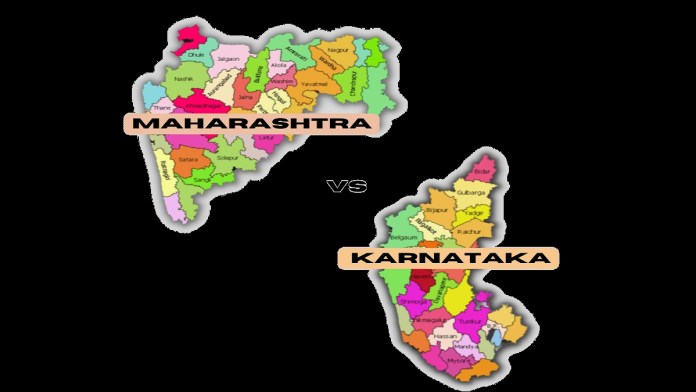As media reports repeated attacks on Maharashtra BJP leaders in Karnataka, vehicles from which were vandalised in Maharashtra, an old dispute between the two states has reared its head again, which escalated into violence yesterday. Belagavi and Pune have been the epicentres of such violence, sometimes taking the shape of an intra-party feud.
Deputy Chief Minister Devendra Fadnavis called Karnataka Chief Minister Basavaraj Bommai, complaining about the attack on him. But what is the Maharashtra-Karnataka border dispute all about?
Maharashtra-Karnataka border dispute
The Maharashtra and Karnataka boundary dispute began along linguistic lines in 1956 when the State Reorganisation Act was passed, proposing to create or separate states on the basis of languages that the majority in a given area spoke. Maharashtra, when formed on 1 May 1960, demanded 865 villages, including Belagavi (then Belgaum), Carvar and Nipani, asking for their merger with Maharashtra. Karnataka refused to let the territory go.
While pressure from Maharashtra made the union government constitute the Mahajan Commission headed by the then Supreme Court Chief Justice Meher Chand Mahajan on 25 October 1966, the commission rejected the state’s claim over Belagavi. The commission instead recommended that 247 villages and other places — like Jatt, Akkalkote and Solapur — be added to Karnataka and 264 villages and places, like Nippani, Khanapur and Nandagad, be turned into areas of Maharashtra.
Maharashtra rejected the commission’s report outright, with successive governments in the state maintaining thereafter that the commission had not addressed its concerns well enough, as the commission ruled in favour of Karnataka.
Attempts to resolve the row have all gone in vain. In 2004, the then-Maharashtra government filed a petition in the Supreme Court, asking for the Marathi-speaking villages in Karnataka, which contested the claim. To assert its claim over the areas, Karnataka renamed Belgaum as Belagavi, making it the second capital of the state.
Where does the Karnataka-Maharashtra border dispute stand now?
Karnataka, as well as Maharashtra, believes that the complicated issue cannot be resolved politically, as it requires a legal solution too, but the Maharashtra-Karnataka border row has been pending before the Supreme Court since 2004. Both states have refused to yield an inch.
Successive union governments have been circumspect over the issue, refusing to throw their weight behind either state. In 2010, the Manmohan Singh government said through its affidavit that the transfer of certain areas to the Mysore province (now Karnataka) was neither arbitrary nor wrong, underscoring that the parliament as well as the union government had considered all relevant factors while considering the State Reorganisation Bill, 1956, and the Bombay Reorganisation Bill, 1960.
How does the dispute spill over to politics?
Politicians from both Maharashtra and Karnataka have used the border dispute to provoke regionalism in the minds of the people during elections. In Maharashtra, for example, every party promises a resolution of the boundary dispute in its election manifesto. It goes to the extent of influencing successive governors’ annual addresses to the joint session of the state legislative assembly and council.
Parties do not differ on this issue, though, just like politicians of a given state do not differ on the issue of the Cauvery water dispute between Karnataka and Tamil Nadu or Assamese politicians would not speak against one another, regardless of what party they belong to, in the state’s dispute with bordering provinces. The ruling BJP and Balasahebanchi Shiv Sena (led by Chief Minister Eknath Shinde) and Shiv Sena (Uddhav Balasaheb Thackeray), INC, NCP and MNS think alike that Marathi-speaking areas along the Karnataka border should merge with Maharashtra.
Meanwhile, NCP honcho Sharad Pawar is reportedly itching to enter the dispute with a predictable pro-Maharashtra stand.
Why has the border dispute resurfaced now?
Because two weeks ago, Maharashtra Chief Minister Shinde reviewed the status of the border dispute at a meeting in Mumbai. He delegated the job of coordinating and pursuing the border row, both legally and politically, to two senior ministers, Chandrakant Patil and Shambhuraj Desai. Further, the chief minister announced that freedom fighters in Belagavi and other Marathi-speaking areas in Karnataka would be eligible for pension and would also get free medical care under the Jyotiba Phule Jan Arogya scheme of Maharashtra!
The next day, in Bengaluru, Karnataka Chief Minister Basavaraj Bommai announced grants for all Kannada language schools in Maharashtra. Bommai said that the Karnataka government was pondering over the idea of claiming more than 40 villages in the Jatt taluka in District Sangli of Maharashtra. The following day, the Karnataka chief minister said his government would claim border villages in District Solapur of Maharashtra.
This provoked Maharashtra Deputy Chief Minister Devendra Fadnavis to assert that the government would “not let a single village go to Karnataka”. Rather, “Maharashtra will reclaim 865 villages, including Belgavi, Nipani and Carvar,” Fadnavis said.
Maharashtra was to send ministers Patil and Desai to visit Belagavi on 6 December to hold discussions with various organisations and people. This proposed visit had to be postponed after the Karnataka government urged them not to send the delegation.
Yesterday, though the Maharashtra ministers put off their Belagavi visit, the Narayan Gowda-led Karnataka Rakshana Vedika went to Belagavi and allegedly attacked buses from Maharashtra, pelting stones at a place called Hiregadwadi near Belagavi. Retaliating, Shiv Sena (UBT) workers defaced Karnataka buses in Pune.




You must log in to post a comment.